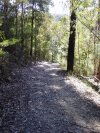You are hereForums / By Discipline / Mountain (off road) / By Location / Australia / NSW / NSW Trail Advocacy / Mountain Bikers and Wilderness zones
Mountain Bikers and Wilderness zones
Poaching the link from rotorbrun
An interesting read about mountain bikers and wilderness.
A bit of back ground Wilderness zones in the USA are currently no go for anything but self powered exploration. For some reason MTb falls outside this and is considered mechanical transport (“propelled by a nonliving power source.) however horse riding is allowed.
In NSW wilderness zones are similarly self powered. MTB is allowed on official maintenance trails and other trails (We're talking fire trail here)with the expressed permission from the Head ranger/
http://sportsyakima.com/2011/08/sandsberry-mount...
The comments are also worth reading through.
I thought this one was very well expressed
I have been back-packing since about 1969 and mountain biking since about 1981. My observation is that, with a mountain bike, you are limited to the amount of stuff you can carry on a multi-day ride, versus what you can carry on your back. You need all that extra stuff when back-packing because you will be camping in more places while walking versus a trip of the same length on a bicycle. Camping definitely has an impact. The tent space is trampled, food is cooked, waste is disposed of, etc. In this way back-packing has more of an impact than bicycling.
The other impact that hiking has over cycling is that it is much easier to go off-trail on foot than on a bicycle.
The waist disposal is something that is usually overlooked when discussing trail impacts. How many walking trail in NP are littered with toilet paper? Just about every popular one. How often do you see that on a MTB trail? The start of the Oaks is the only place I've noticed it and that's hardly a mtb only trail.
Anyway it's an interesting read and not the first time an ultra conservative bush walker has come out in support of MTB in USA wilderness zones
Take this article by Andy Kerr from 2003 for example
- Login to post comments
- Bookmark & share

While we're on the topic of wilderness and impact, has anyone heard any progress recently on mtb access into SCA areas around the Warragamba catchment? So much potential there for epic mtb day trips with, as Flynny says, much less impact than overnight walkers camping.
The silence from the SCA is deafening.
Not sure I agree. I hear and understand the comment that making camp over a multi-day hiking journey has an impact on the localised environment. But more than bike riding? Mmmm, maybe. If you are comparing one hiker compared to one Mtb rider, well yes I would agree the hiker may make a larger impact on the environment (particularly campfires etc) compared to the cyclist. But cyclists never spread out all over the terrain. They usually keep to one trail, through the bush, that gets used over and over again. On a one-hiker v one-rider basis, I think the cyclist has a smaller impact. On a one-hiker v many cyclists through the same piece of trail, for sure the cyclists will leave an impact on the trail, more than many walkers will. Manly Dam is your stand out example of this.
Im sure that if there was as many walkers going around the dam as mountain bikers, the impacts (that exsist becuase of poor trail design or location) from both mountain bikers and walkers would be similar.
Walkers have thier purpose built tracks going up the creeklines with steps, bridges, armour and very nice northshore style boardwalks to reduce walker impact. Because of this, those trails suffer litle impact, but one can only imagine the cost over the years to build all that and maintain it.
Point is, never underestimate the impact of many walkers.
The reason walkers seem to not have much impact, is that they have single use trails allready been built at huge cost all over Australia.
Look at the cost of this one:
http://www.premier.sa.gov.au/images/stories/medi...
Walkers have similar impact to mountain bikers, and walking trails cost much more to build and maintain.
If a track around Manly dam was the only bush walking track available to walkers on the northern beaches (apart from a few out-and-back electricity fire trails perhaps), then it would be a heavily used walking track.
There are so many options for walkers who want to go off road that they can spread their impact around much better than mtb riders are able to at present.
Dispersion is key and has been a key point of discussion with NPWS over the last 3 years. They get this and will be studying the pilots in detail to get more data. Even if the pilots get high intensive use and show wear this may not be a bad thing. To me this just means good data, accelerated aging (good for costing maintance budgets) and justification for more trails.
Of interest is that multiplying out basic ABS statistical data for recreation activities indicates that nationally bush walker and mountain biker numbers are roughly equal. However as we know we are concentrated on a much smaller area.
What seems to be taking government by surprise is mtbing is now mainstream. A big change over the last 20 years. The response to annual visitation numbers quoted by us for various areas has been initial disbelief by a number of land managers.
These numbers are now being backed up by independent audits. The good news is we can easily show bike trails are one of the most cost effective recreation asset per visitation around. Much cheaper than sports fields and swimming pools. This makes it easier to push for funding.